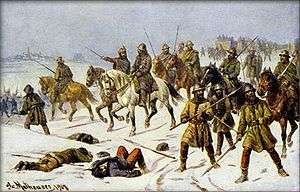Battle of Kutná Hora
| Battle of Kutná Hora | |||||||
|---|---|---|---|---|---|---|---|
| Part of the Hussite Wars | |||||||
 Josef Mathauser - Jan Žižka in front of Kutná Hora | |||||||
| |||||||
| Belligerents | |||||||
|
|
| ||||||
| Commanders and leaders | |||||||
|
|
| ||||||
| Strength | |||||||
| 12,000-18,000 |
50,000-92,000[1]
| ||||||
| Casualties and losses | |||||||
| Unknown, but lesser than the Royalists | 2,000-12,000 men | ||||||
The Battle of Kutná Hora (Kuttenberg), an early battle and subsequent campaign in the Hussite Wars, was fought on 21–2 December 1421 between German and Hungarian troops of the Holy Roman Empire and the Hussites, an early ecclesiastical reformist group that was founded in what is now the Czech Republic.
In 1419, Pope Martin V declared a crusade against the Hussites. One branch of the Hussites, known as the Taborites, formed a religious-military community at Tábor. Under the leadership of the talented general Jan Žižka, the Taborites adopted the latest weaponry available, including handguns, long, thin cannons, nicknamed "snakes", and war wagons.[2] Their adoption of the latter gave them the ability to fight a flexible and mobile style of warfare.[2][3] Originally employed as a measure of last resort, its effectiveness against the royal cavalry turned field artillery into firm part of Hussite armies.
Background
The battle
At Kutna Hora in the early winter of 1421, the Taborites were encircled by the superior forces of the Holy Roman Empire under King Sigismund.[2] Even though Sigismund's elite heavy cavalry was kept at bay by Zizka's artillery, the Taborites apparently faced imminent destruction.[2] However, on 21 December, Zizka grouped his war wagons into a column and charged the enemy lines. The battle wagons advanced rapidly, with all of their guns blazing.[2] The column smashed a hole through Sigismund's line, allowing the Taborites to escape the encirclement.[2] Sigismund decided against mounting a pursuit of the Hussites, for he incorrectly believed that they had been utterly defeated.[2]
Aftermath
Zizka, throughout the rest of December, launched numerous counter-offensives and raids on the Germans' lines. He also introduced the use of small firearms for large bodies of infantry, eventually equipping a third of his infantry.[4] His normal tactic was to mount raids that would draw his opponent into attacking his wagon fort, then, at the right moment, sortie out of the fort with his cavalry, bowmen, and pikemen to ravage the enemy forces.[2] His manoeuvres were quite successful, and, as a result, by the end of the month, Sigismund's demoralized army, constantly harried by Zizka's seemingly invincible soldiers, fled Bohemia.[2]
References
- ↑ WINDECKE, Eberhard (1893). Denkwürdigkeiten zur Geschichte des Zeitalters Kaiser Sigmunds (in German). Berlin: Wilhelm Altmann.
- 1 2 3 4 5 6 7 8 9 Hussite Battles and significant events
- ↑ Setton, Kenneth Meyer (1975). A History of the Crusades: The fourteenth and fifteenth centuries. Univ of Wisconsin Press. p. 604.
- ↑ Sedlar, Jean W. (1994), A history of East Central Europe: East Central Europe in the Middle Ages, University of Washington Press. p. 234. ISBN 0-295-97290-4
Coordinates: 49°0′57″N 15°0′16″E / 49.01583°N 15.00444°E